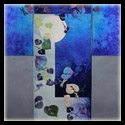I’ve always found beaches to be an incredible source of inspiration for me. We’re lucky here in the Pacific Northwest to be surrounded with water, mountains, and greenery. Every once in a while, we even get to bask in some sunshine out in nature.
This weekend, I was up at our getaway on Whidbey Island, a 2 hour trip from our home. The day cleared up for a short while and I took our dog for a beach walk. What a glorious day. This great blue heron was a little far for my camera lens (and my dog was a little too close for his comfort to stay while we advanced towards him!) But I loved the composition and think I could make a lovely pictorial quilt from this photo.
While I love beaches and sea creatures, one could imagine they might cause some bittersweet feelings for me. Many years ago I was an extremely active scuba diver. I was a certified PADI rescue diver and was working on my Divemaster certification. I assist-taught classes for beginning scuba, which meant I was diving a minimum of twice a week. I was a diver for the Seattle Aquarium, giving shows of hand-feeding the fish (even the 4-5 foot dogfish, a native shark) on a regular basis. For those of your from warm climates, go ahead a shiver… the Puget Sound is about 40-42 degrees F. year-round. But the diversity of sea life is incredible in our region. It’s like going to the Amazon rain forest, only under water.
Unfortunately, while I was starting my second year in college in oceanography/ marine biology, I had a diving mishap and ended up in a decompression chamber. It was never 100% certain that I actually had “the bends” or whether I had a pinched nerve from carrying the heavy tank on my back. However, the result was that I needed to choose to either quit diving or risk the potential of a serious or life-threatening injury if I were to continue.
I chose to turn the page to a new chapter in my life. I also still choose to find joy in beaches and the sea life that I can experience, rather than holding any negativity or resentment towards my loss. Even though I won’t ever really get to have the incredible experience of being weightless and discovering the underwater world again, I cherish my memories. I’d love to do more artwork based on our native Northwest marine life.
One of my friends from the Contemporary QuiltArt Association, Carla Stehr, makes incredible quilts based on photographs she takes with a scanning electron microscope for her job at NOAA. She has even published a beautiful book of photographs called “Sea Unseen” of these microscopic organisms. Here is a video of Carla speaking about her work and it’s influence on her artwork:

Note: If you’re interested in obtaining a copy of Carla’s book “Sea Unseen”, she does have a few copies still available for sale. Let me know via a comment and I’ll get you in touch with her.
Another wonderful aspect of the beach is finding treasures, such as this rusty grate which I found this weekend. I’ve been saving up some rusted pieces of metal that I’ve collected off the beach and this one takes the prize! I think the patterning will make some amazing rust-dyed fabric.
How do you feed your creative muse? Do you have special places to go to be inspired?
You might also be interested in:
 |
 |
 |
| Viewing for Inspiration | Sunshine and Sand- Design Inspiration |
Golden Hour at Penn Cove & Monet’s Haystacks |

































